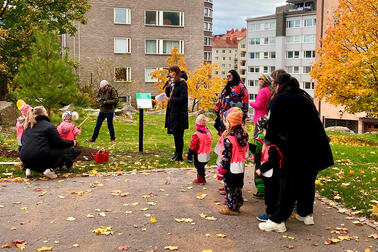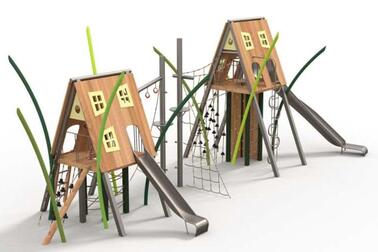
Playground activities 110 years
Makasiinipuisto park by the Central Library Oodi gathered 200 children and adults to celebrate together.
Makasiinipuisto park by the Central Library Oodi gathered 200 children and adults to celebrate together. Video text and audio in Finnish.
Together with Deputy Mayor for Education Johanna Laisaari, Helsinki Mayor Juhana Vartiainen participated in the event, acknowledging the value of the playground activities and the meaning of play in children’s development and in the support of integration in his speech. Minister of Youth, Sport and Physical Activity Sandra Bergqvist gave praise to the playground staff and their invaluable contribution for children. Finally, the children and speakers had good fun playing the new winning game together.
Where it all began?
As the city of Helsinki grew rapidly at the end of the 19th century, spaces for children’s play dwindled. Residents complained that there was insufficient space for schoolchildren to play ball games.
The aim was to increase the commitment of children and the working class to society and to improve their wellbeing. Architects in urban planning alongside a wide range of education professionals wanted to contribute to solving the society’s problems. Play and parks played an important role in this.
Playgrounds come to Helsinki
Playgrounds began to be established in the city following an initiative by the Finnish Gymnastics Teachers’ Association in 1913, which proposed introducing guided play activities in Helsinki. In 1914, playground activities started in Kapteeninpuistikko park in the Ullanlinna district, Kallio Primary School, Lapinlahdenkatu park in the Kamppi district, and the small field in the Kaisaniemi district.
The guided play activities were a summer pastime for all children, regardless of their background. Each playground was usually supervised by three instructors. As years went by, children who had played there, became new instructors.
Playgrounds evolve
In the summer of 1942, food distribution began in Helsinki’s playgrounds. This unique tradition continues today. As playgrounds became more popular, the city set up a committee to consider how to improve them. A first-class playground had to be a fenced area of at least one hectare, part of which was to be designated as a playground for older children and another part as a playground for small children. There was to be a building on the site for the instructor, for warming up in and for storing equipment. In addition, there needed to be a wading pool, areas for building things, an area to play house, swings, a carousel, a slide, a water supply, a toilet and, an ice-skating rink in wintertime, a cross-country skiing track and a sledging hill.

The administrative status of playgrounds became permanent in 1951, when they were finally incorporated into municipalities. By the 1990s, playgrounds were already starting to be seen as a meeting place for the entire neighbourhood, where everyone from babies to grandparents was welcome.
Playground activities now and in the future
Today, Helsinki has a network of approximately 60 playgrounds and family houses spread across the city that are open year-round. They offer a wide range of services to the area’s residents of all ages. The playgrounds, which are open to all, free of charge, and professionally run, are a unique Helsinki phenomenon in their extent. They are the result of 110 years of ambitious development efforts.
The City of Helsinki’s playgrounds now offer open early childhood education clubs for two to four-year-olds, after-school activities for schoolchildren and dedicated sessions for families with babies. Parks also continue to play a big role as the city’s meeting place for people of all ages and backgrounds.
Helsinki’s playground network will be further supplemented by developing the existing playgrounds and building more themed playgrounds or play areas around the city. For example, the world’s first computer-themed playground, designed in close cooperation with pedagogical experts from the City of Helsinki, is expected to be built in the Ruoholahti district in the autumn. The playground’s users – the children and employees of the area – have also been heard in the design of the playground.
Summer activities and summer meals
The playgrounds offer many activities in the summer, during the schools’ summer holiday. For a summary of playground summer activities, day camps and opening hours, visit the Summer at the playgrounds page.
Summer meals, which mean free hot lunches for all children under 16, will be provided at the playgrounds that are open from 3 June to 2 August 2024. For information on playground meals and the summer meal menu, please visit the Playgrounds’ summer meals page(Link leads to external service) .
See you at the playground!
The source for the article is text from Jere Jäppinen’s work, “On meillä nasta täti - leikkikenttien vanhoja laululeikkejä”.


